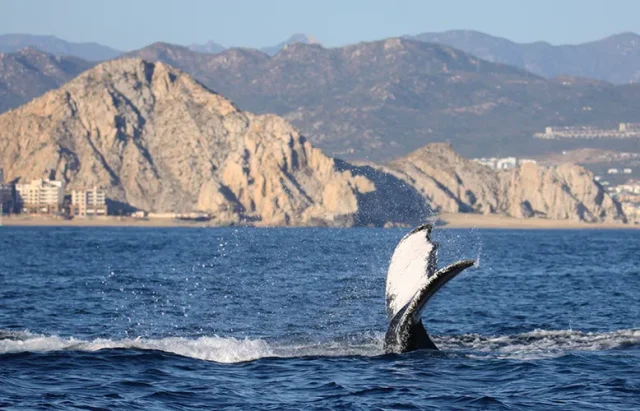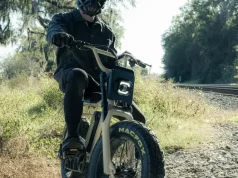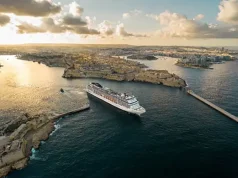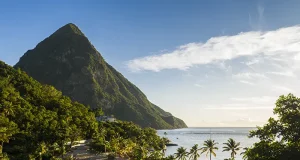
The walls of the Los Gigantes are basalt and rise 500-600 meters straight up out of the Atlantic, dark and brooding. But what is most interesting about this spot isn’t simply the cliffs. A pod of short-finned pilot whales makes their home there, feeding in the submarine canyon that plunges from the base of the cliff down beyond 1,000 meters. So when you whale watch in Los Gigantes, you get whales, plus this bananas geological setting that makes the whole experience different.
Those vertical rock faces don’t peter out at the waterline. They continue to go underwater down walls that descend into the Teno-Rasca corridor, a deep channel between Tenerife and La Gomera. You have to travel half a kilometer offshore, and you’re over 30-50 meters of water. Out at two kilometers, the bottom’s at 200 to 300 meters.
This approach enables whale watching in Los Gigantes to find whales sooner than boats operating from the south. The marina is just below the cliffs, and it takes vessels only 15 to 20 minutes to row out to where pilot whales make regular appearances. Plus you have this visual thing where 6-meter whales come up in front of 600-meter cliffs. The scale is wild.
The Marine Life You’ll See
The true goal is short-finned pilot whales. The resident population is approximately 250-300 animals that live in stable family groups year-round. These aren’t whales passing through. They remain because the food supply is functional.
They are visible with about 85-90% certainty in either half of the year, based on local weather. Pilot whales engage in “logging,” during which they hang apparently motionless at the surface between deep dives. Makes for solid viewing time. Average sightings are in private trade rafts, with around 15-30 whales spread out over a few hundred meters. They pop up sporadically for a breath: 5-8 gulps of air, then back down to depths of 2000-3000 feet, grabbing squids from the deep for about 8 to 15 minutes.
Bottlenose dolphins make frequent appearances, often nearer to shore. They love bow-riding — 8 to 20 in a group surfing the pressure wave of your boat. You may see loggerhead turtles, the odd fin whale, and Atlantic spotted dolphins in summer. The cliffs are home to bird colonies, with white guano clearly visible on dark rock.
What Happens on the Tour
Most tours follow standard routes. You exit at Puerto Deportivo, a tiny marina with perhaps 30 slips. Gray, cream, and black walls of wavy sandstone rise up to 300 feet from the river’s edge; getting out from under them is surreal, like steering down a slot that abruptly widens into the ocean.
The northern section goes straight up the cliff base, 10-15 minutes. You’re moving through looms of where there was rockfall, and it built up a slope, and then the wall drops dead. Bottlenose dolphins often appear here. Once you pass the cliffs, boats head west into deeper water. The seafloor drops down to 200+ meters at less than a kilometer. This is pilot whale territory.
Under Spanish law, boats remain at least 60 meters from whales, must slow down to under four knots when in proximity, and may spend just 30 minutes with any given group. Good operators follow these rules. Sixty meters is close enough to see plenty with the naked eye or through binoculars. There’s the outline of a dorsal fin, there’s the bulbous forehead that pilot whales have, and then you can see they’re dark gray.
An encounter typically lasts 20-40 minutes as the pod lies at rest and dives. Calves stick close to their mothers. Sometimes whales spy-hop (poke heads up vertically) or slap tail flukes or burst with speed. But now, pilot whales are generally peaceful.
After whale time, several tours stop at sheltered coves so passengers can swim. Masca Bay is often used. Water’s stupidly clear, 20+ m vis for days. Some operators may also serve Canarian wine or beer with cheese and bread produced on the islands.
And on the way back, you get various lights on cliffs as time passes. By the afternoon, tours have people facing directly into the western sun. The early-morning tours see cliffs silhouetted, but water throws back light on lower sections. The whole process usually takes 2-3 hours. The boats range from 8-meter inflatables that carry as many as 12 people to 15-meter catamarans that can hold up to 40 or even 50.
Getting There and Costs
Los Gigantes is 30-35 km from the southern tourist areas, about 35-40 minutes by car. If you drive, take TF-1 highway north to Guía de Isora exit; then follow the TF-454 west. Bus line 473 connects Playa de las Américas and Los Gigantes (50–60 mins). Taxi runs €40-55 one way.
Tours are €45-70 per adult, depending on boat size and how long you want to be at sea. Kids get 30-50% off. Most operators include drinks—reserve in advance, June to September, when tours sell out. The sea can be smoother on morning trips, roughly from 9:00 to 10:30 a.m., than in the afternoons. West winds turn choppy by 2:00, 3:00 PM.
Bring high SPF water-resistant sunscreen (the cliff reflection ramps up UV), a wide hat with chin strap (the wind gets everyone’s unsecured hats), polarized sunglasses (lowers glare — you’re supposed to watch for whales) a light jacket (even though the air is warm, it can feel cool in the shade), wear your swimsuit under your clothes and have a waterproof case for your phone on hand (salt spray touches everything).
Summer June – September brings glassy mornings with 0.5 m- 1 m waves, slowly building to 1-2 meters during the afternoon. Winter becomes more unpredictable with 2-3 meter swells as one of the North Atlantic storms passes. Approximately 10-15% of customers suffer mild motion discomfort. If worried, go for a bigger boat and medicate yourself 30 to 60 minutes before you leave.
Why Pick Los Gigantes
It is possible to see whales from several Tenerife ports in the southwest. All tours have the same population of pilot whales, so the odds of seeing whales remain roughly equal. The difference is in the overall experience.
Los Gigantes advantages: Those cliffs provide visuals you don’t get anywhere else. A less commercial, smaller marina with 6-8 companies. Less travel time, more whale time.” The village is less noisy than the southern coast resort areas.
Trade-offs: The distance from the southern resorts is an additional 30 to 40 minutes each way, and there is less flexibility: many users have less flexible schedules. Western orientation means the afternoon wind can be a bit much. And really, pilot whales are the same anywhere you’re watching from.
Comes down to priorities. Photographers benefit from the cliff backdrop. Suppose you prefer a smaller crowd, like the marina vibe. If you’re staying in western Tenerife, Los Gigantes makes sense geographically. And for operators established in southerly resorts focused on ease or craving lots of operator options, southern pylons likely remain the better choice.
Timing Matters
Pilot whales live here year-round. The best flat conditions (calm seas) are in summer, 85-90% of the day, with favourable conditions. Winter becomes more variable; good conditions decrease to 60-70%.
“Morning tours” (9:00-11:00) traverse calmer waters before the wind picks up later in the day. Eastern sun on the cliff faces is better for photos and viewing whale blows. Afternoon tours are more likely to have wind and trickier backlighting; killer light on cliffs during the return.
The temperature of water in winter is 19-20°C, and in summer, 23-24°C. Suitable for fast swimming, when you don’t have time to dry off before diving in. The visibility for Snorkeling is good from summer, when plankton blooms are less, and gives a 20-30 meter view, standing at a MEAN high of around 10-15 meters, in winter.
What Makes This Different
What makes whale watching in Los Gigantes unique is the aesthetic union of geology and marine life. The whales are there along the southwest coast of Tenerife and exhibit the same behaviors. The difference is setting: 600-meter cliffs rising behind a surfacing whale makes a theatrical sense that open-ocean encounters don’t.
The cliffs are a visible part of the geological processes that formed a submarine landscape, attracting pilot whales. The same volcanic activity that built the Teno massif also gave rise to the submarine canyon where whales hunt. Geography and biology connect.
Los Gigantes makes a good choice for first-time whale watchers visiting Tenerife on boat trips. Not that whales are unique, just that context makes an observation special. That extra 30 minutes of travel buys you something specific: pilot whales surfacing under cliffs of a height to dwarf even these six-meter animals, scale rather than simply wildlife-watching.





